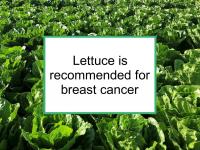By lettuce (Lactuca sativa), we mean iceberg, romaine, red leaf, or butterhead (Boston, bibb) lettuce. Not included in the lettuce category is arugula, a cruciferous vegetable. Lettuce is a good dietary source of vitamin A (from its relatively high beta-carotene content), lutein, folate and vitamin K, and also contains some cadmium and quercetin.
Generally speaking, romaine lettuce is far more nutritious than iceberg lettuce, with higher levels of these micronutrients. Bibb lettuce and red leaf lettuce fall in between. Lettuce has been shown to have antioxidant properties (but lower than most other vegetables) and to improve cholesterol profile. Lettuce consumption has been found to be associated with lower risks of lung, gastric, bladder and colorectal cancer.
Breast cancer-related effects of eating lettuce
A Japanese study found that frequent lettuce consumption was associated with lower risk of breast cancer. One Mexican study found that consumption of lettuce was associated with lower risk of breast cancer in premenopausal women. A Greek study found that women with breast cancer consumed significantly less lettuce than those without breast cancer.
Lutein consumption and circulating lutein levels have been found to be associated with reduced risk of breast cancer in several epidemiological studies. Lutein has been shown to inhibit the progression of both ER+/PR+ and triple negative (ER-/PR-/HER2-) breast cancer cells under hypoxia, a low-oxygen condition in which solid breast tumors can thrive. Lutein has also been shown to potentiate the effect of taxane chemotherapy drugs (paclitaxel and docetaxel) in breast cancer cells.
Quercetin, found primarily in romaine lettuce, has been reported to increase the effectiveness of doxorubicin, paclitaxel, and 5-fluorouracil (5-FU) chemotherapy in ER+/PR+ breast cancer cells. Quercetin has also been shown to inhibit aromatase, thereby supporting anti-estrogen treatment. In addition, quercetin has been found to inhibit the migration and adhesion of triple negative breast cancer cells and to significantly inhibit tumor progression in a mouse model of triple negative breast cancer. Quercetin has also been shown to enhance the anti-tumor activity of cisplatin while reducing it's adverse side effects.
Additional comments
Non-organic lettuce must be washed very thoroughly to remove pesticide residue as much as possible. Outbreaks of E. coli, salmonella, and shigellosis infections linked to lettuce occur from time to time. Consumers should stay aware of and act upon any such reports.
Endive and radicchio
Like endive (Cichorium endivia), radicchio (Cichorium intybus) is a member of the chicory family and is not a variety of lettuce. Radicchio has an appearance reminiscent of the white veins and dark red leaves of red cabbage. The head can be round like cabbage or elongated like romaine lettuce. Radicchio has among the highest levels of luteolin among vegetables. Luteolin has been shown to inhibit angiogenesis (new blood vessel formation) and aromatase activity (in which androgens are converted into estrogens) in the laboratory. Luteolin has also been found to suppress triple negative breast cancer cell proliferation and metastasis and to reduce ER+/PR+ cell viability in a dose- and time-dependent manner.
Sources of information provided in this webpage
The information above, which is updated continually as new research becomes available, has been developed based solely on the results of academic studies. Clicking on any of the underlined terms will take you to its tag or webpage, which contain more extensive information.
Below are links to 20 recent studies concerning this food and its components. For a more complete list of studies, please click on lettuce.
